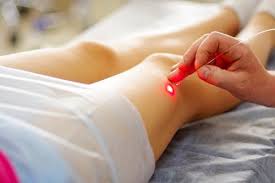 Millions of both men and women are bothered by the embarrassment and discomfort of spider veins on their legs or faces. Spider veins are those small red, blue and sometimes purple blood vessels that appear on the surface of the skin and are usually asymptomatic. In some circumstances, when the spider veins get larger in size or surface area they can cause some minor symptoms.
Millions of both men and women are bothered by the embarrassment and discomfort of spider veins on their legs or faces. Spider veins are those small red, blue and sometimes purple blood vessels that appear on the surface of the skin and are usually asymptomatic. In some circumstances, when the spider veins get larger in size or surface area they can cause some minor symptoms.
A varicose vein is an entirely different animal. These are tortuous large veins that have lost the function of the one-way valves that keep the blood from pooling. Without those valves, the blood pools in the veins and decreases the ability to adequately perfuse oxygen to the tissue and remove waste from a specific area of a leg. Treatment for varicose veins has progressed over the years. Initially, individuals were recommended to sit with their feet elevated as much as possible during the day. Next, manufacturers produced support hose which helped to move the blood along in the venous system towards the heart. Surgeons then began using a vein stripping technique where the vein itself was removed from the body. Today, less invasive treatments are available, such as sclerotherapy and laser treatment that causes the veins to collapse and eventually become reabsorbed by the body.
This venous laser treatment works by thermal destruction of the vein tissue. The laser energy is delivered to the area of the vein that is incompetent and a variety of wavelengths are used. When the laser is fired, thermal energy is deposited in the blood and venous tissues causing irreversible localized damage. The entire vessel is treated and, although a hole may be made during the laser treatment, permanent changes are caused by the thermal injury. (1,2)
 Prior to the procedure your physician will evaluate your health and situation to determine whether or not you are a good candidate. Be sure to report all medications that you are currently taking, including herbal supplements and multivitamins. If you have any allergies, especially to local anesthetic or general anesthetic, you must also advise your physician. Your doctor will talk to you about removing any aspirin, nonsteroidal anti-inflammatory drugs or blood thinners for a specific period of time prior to the procedure in order to decrease the risk of bleeding.
Prior to the procedure your physician will evaluate your health and situation to determine whether or not you are a good candidate. Be sure to report all medications that you are currently taking, including herbal supplements and multivitamins. If you have any allergies, especially to local anesthetic or general anesthetic, you must also advise your physician. Your doctor will talk to you about removing any aspirin, nonsteroidal anti-inflammatory drugs or blood thinners for a specific period of time prior to the procedure in order to decrease the risk of bleeding.
Arrive for the procedure wearing comfortable loose fitting clothing. Be sure to bring a friend or relative with you in order to have them drive you home after the procedure. Your doctor will most likely order compression stockings for use after the procedure in order to reduce the likelihood of bruising and tenderness. These stockings should be worn for approximately one week and are often kept in place continuously for the first 72 hours. Patients are encouraged to do aerobic activity and are highly discouraged or are forbidden from bed rest, hot baths, heavy lifting or long travel for approximately one to two weeks.
Reports of any major complications are very rare. Patients who are not good candidates for laser therapy are those who are allergic to local anesthetic, have current infections in their legs, lymphedema, nonambulatory patients, experienced peripheral arterial insufficiency or are in poor general health. Women who are pregnant or those who have had an active venous thromboembolism should also not undergo this procedure.
The benefits include no surgical incision and a relatively non-invasive procedure. The treatment is more effective than traditional vein stripping and is associated with less pain and fewer complications during recovery. The procedure leaves virtually no scars and patients are usually able to return to daily activities immediately.
As with any procedure that penetrates the skin there is a risk of infection, tenderness, heat damage to the nerves or inflammation of the vein (thrombophlebitis). Any blood clots that may form in the veins can potentially travel to the lungs, but this is an extremely rare problem.
Laser treatment for spider veins doesn’t make any puncture into the vein or skin. The laser is applied over the skin. Patients describe the experience like having a small rubber band snapping against the skin. The veins usually disappear over the next 2-6 weeks.
References:
(1) Medical Journal of Australia: Treatment of Varicose Veins by Endovenous Laser Therapy: Assessment of Results by Ultrasound Surveillance
(2) Cleveland Clinic: Endovenous Thermal Ablation
http://my.clevelandclinic.org/services/vascular_surgery/vs_endovenous_thermal_ablation.aspx


Leave a Reply